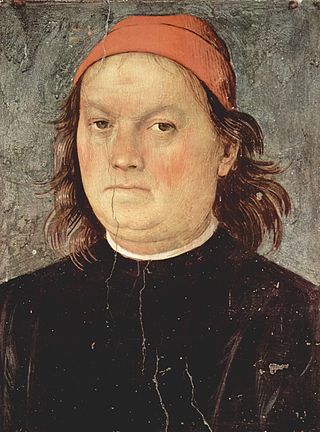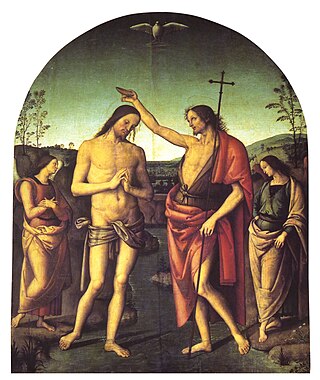
Pietro Perugino, an Italian Renaissance painter of the Umbrian school, developed some of the qualities that found classic expression in the High Renaissance. Raphael became his most famous pupil.

The Marriage of the Virgin is a painting by the Italian Renaissance master Perugino, although it is now sometimes attributed to his pupil Lo Spagna. It depicts the marriage between Joseph and Mary, and is now in the Musée des Beaux-Arts of Caen, France. Initially commissioned to Pinturicchio for the recently completed cathedral of Perugia, Perugino took over the commission and finished the work around 1500–1504, probably after several periods of stasis.

The Tezi Altarpiece is a painting by the Italian Renaissance painter Pietro Perugino, housed in the Galleria Nazionale dell'Umbria of Perugia, Italy. The work was once associated to a single predella panel portraying the Last Supper, now at the Gemäldegalerie of Berlin.

The Lamentation over the Dead Christ is a painting of the common subject of the Lamentation of Christ by the Italian Renaissance painter Pietro Perugino, executed in 1495 and now in the Galleria Palatina of Palazzo Pitti, Florence, Italy.

Decemviri Altarpiece is a painting by the Italian Renaissance artist Pietro Perugino, executed in 1495–1496, and housed in the Pinacoteca Vaticana in Vatican City.

Adoration of the Magi is a 1504 fresco by Perugino in the Oratorio di Santa Maria dei Bianchi in Città della Pieve. It shows the Adoration of the Magi, with an idealised view from Città della Pieve towards Lake Trasimene and Val di Chiana in the background. It is often compared to the Adoration of the Magi in the Sala delle Udienze del Collegio del Cambio in Perugia by Perugino and his studio, which includes areas argued by some art historians to have been painted by a young Raphael.

Madonna della Consolazione is an oil on panel painting by Perugino, datable ca. around 1496–1498. The work, completed in April 1498, was carried out in the Sala delle Udienze of the Collegio del Cambio. Since c. 1820 it is preserved in the National Gallery of Umbria in Perugia.

Baptism of Christ is a c.1510 painting of the Baptism of Christ by Pietro Perugino. He produced it for the chapel of St John the Baptist in Città della Pieve Cathedral, where it still hangs. Unusually for a depiction of this subject, it does not show the face of God the Father. A multi-coloured marble frame was added in the Baroque period and a copy of Perugino's self-portrait now hangs another wall in the chapel.

Miracle of the Snow is a painting in tempera on panel by Pietro Perugino, dating to around 1472–1474 and now in the collection of Polesden Lacey. It shows the miraculous fall of snow which marked the spot for the foundation of Santa Maria Maggiore in Rome in 352. The painting belongs to Perugino's early period and the important commissions he gained during the short time he was active in Florence. Both it and the Nativity of the Virgin are usually identified as one of two surviving parts of the same predella, either from a lost altarpiece of the Virgin Mary or from the Pala di San Martino a Strada by Andrea del Verrocchio's studio. Both predella panels were in the Pucci chapel in Santissima Annunziata in Florence by 1786, when they were bought by John Campbell. They were sold to different owners in London in 1804, with the Miracle entering the Polesden Lacey collection.

Madonna and Child with the Infant John the Baptist is an oil on oak panel painting by Perugino, dating to around 1497 and now in the Städel Museum in Frankfurt-am-Main

The Corciano Altarpiece is a 1513 painting by Perugino now in the parish church of Santa Maria in Corciano. It was produced following a past commission for Perugino to decorate the high altar of the parish church in Corciano.

The Transfiguration Altarpiece is an altarpiece of the Transfiguration of Jesus by Perugino, dating to 1517 and now in the Galleria Nazionale dell'Umbria in Perugia.

Madonna and Child with St Herculanus and St Constantius or Madonna of the Kitchen is a 1515 painting by Perugino, now in the Galleria Nazionale dell'Umbria in Perugia. Its title refers to the fact that it once hung in the former kitchen of the Palazzo dei Priori in Perugia. The two accompanying saints are Herculanus and Constantius, both local saints to Perugia.

The Madonna of Loreto is a c.1507 oil on panel painting by Perugino, now in the National Gallery, London, which bought it in 1879. It shows the Madonna and Child flanked by Jerome (left) and Francis of Assisi (right). Two angels hover over Mary's head holding a crown. It reuses the low parapet from Madonna and Child with St Rose and St Catherine (1492) and probably also involved the master's studio assistants.

'Madonna of Graces with Two Saints is a 1522 fresco painting by Perugino. Its central figure shows Mary as Our Lady of Graces, flanked by Antony the Great and Antony of Padua. It is in a side chapel of the church of Sant’Agnese, the Poor Clares convent in Perugia. It was commissioned a year before the painter's death by Eufrasia and Teodora, two nuns of the convent.

The Spello Pietà is a fresco of the Pietà by Perugino executed in 1521–1522. It also shows John the Apostle and Mary Magdalene kneeling either side of the Virgin Mary. It is now sited in the left transept of the Chiesa Santa Maria Maggiore in Spello, but its origins are unknown.

The Fontignano Madonna is a 1522 fresco Madonna and Child by Perugino. Angniolus Toni Angeli and the Confraternity of the Annunciation commissioned him to decorate their church of S. Maria dell'Annunziata in Fontignano in 1521. It is his only surviving work in the church and probably reused his cartoons from Santa Maria Maggiore in Spello, such as those for the Spello Pietà. Angeli's name appears at the base of the work.

The Pietà Gonfalon is a c. 1472 tempera on canvas painting by Pietro Perugino, now in the Galleria Nazionale dell'Umbria in Perugia. It was produced as a gonfalon or processional banner for the Franciscan monastery at Farneto, near Perugia. It is an early work by the artist and shows the Pietà.

Ascension of Christ is a c.1496-1500 oil painting by Pietro Perugino, now in the musée des Beaux-Arts de Lyon. It was the prototype for his Sansepolcro Altarpiece. it has dimensions of 325 centimeters in height and 265 in width.



















